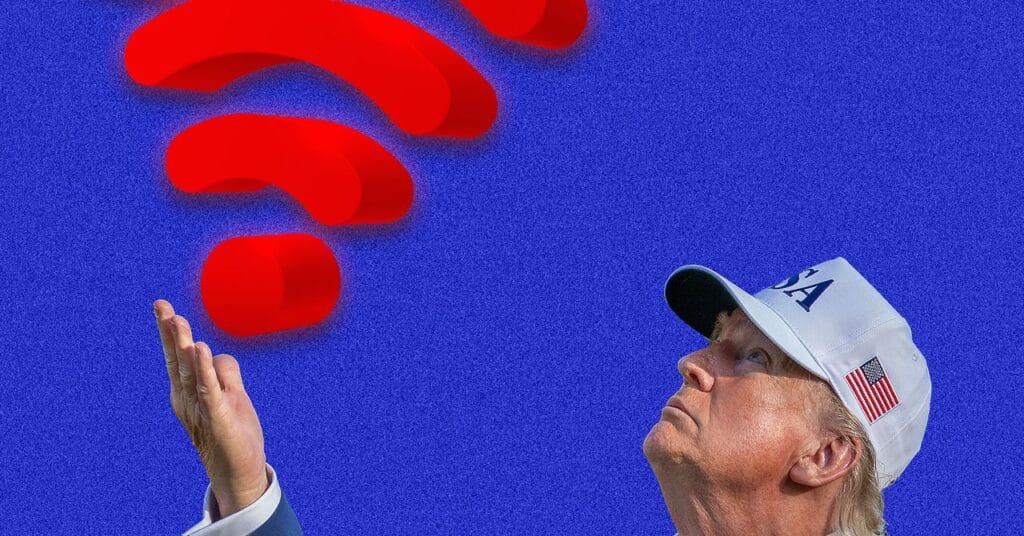The Federal Communications Fee has regained its authority to carry spectrum auctions and will use that energy to take spectrum away from Wi-Fi networks and license it to cellular carriers AT&T, Verizon, and T-Cell.
As we beforehand wrote, the Senate funds invoice pitched by Ted Cruz (R-Texas) known as for at the least 800 MHz to be auctioned and allowed a part of it to be taken from the 6 GHz band that is getting used to spice up speeds within the new era of Wi-Fi networks. The Home beforehand voted to exclude your entire 6 GHz band from spectrum auctions however finally adopted the Senate’s language in a 218-214 vote when it authorized the ultimate funds invoice on July 3. It was signed into regulation by President Trump on July 4.
The brand new regulation additionally permits spectrum to be taken from the Residents Broadband Radio Service (CBRS), which fits from 3.55 to three.7 GHz. Whereas different spectrum bands might be focused too, advocates say it might be exhausting for the FCC to satisfy the congressional mandate with out taking spectrum from Wi-Fi, CBRS, or each.
The Wi-fi Web Service Suppliers Affiliation (WISPA), which represents small ISPs, stated that “the overwhelming majority of WISPA members make use of CBRS and/or 6 GHz companies to ship broadband to their rural and under-resourced communities.” WISPA stated it is grateful for the brand new regulation’s tax breaks however that these advantages are more likely to be “offset by the package deal’s stance on spectrum. Extra particularly, in its quest to generate revenues to pay for the laws, it doubtlessly places CBRS and 6 GHz spectrum on the public sale block on the FCC.”
The 1,200 MHz between 5.925 and seven.125 GHz was allotted to Wi-Fi in April 2020 below then-FCC Chairman Ajit Pai. The Pai-led FCC rejected the cellular business’s requests to make use of the band for mobile networks, saying that making your entire 6 GHz accessible to Wi-Fi on an unlicensed foundation would promote “extra environment friendly and productive use of the spectrum” by serving to Wi-Fi speeds sustain with rising residence web speeds.
Pai is now CEO of the CTIA, the foremost foyer group representing cellular carriers who need entry to the 6 GHz band. Pai hailed the brand new regulation’s passage in a press release.
“This crucial laws will gasoline America’s wi-fi networks with the spectrum wanted to fulfill quickly rising client demand and safe America’s management within the industries and improvements of the longer term. And the tax provisions are very important to advancing infrastructure funding, creating jobs, and rising the financial system,” Pai stated. “Specific because of President Trump, Senate Commerce Committee Chairman Ted Cruz, and Home Power and Commerce Committee Chairman Brett Guthrie for his or her daring imaginative and prescient and dedication.”
CTIA Desires Higher Half of 6 GHz Band
A CTIA spokesperson instructed Ars not too long ago that the “higher 6 GHz band is the subsequent international 5G band” and that many nations are “utilizing or planning to make use of at the least the higher a part of the band (6.425–7.125 GHz) for licensed industrial use.” This means that the CTIA will likely be lobbying for a big chunk of 6 GHz to be allotted to cellular suppliers.
CTIA has repeatedly claimed that US carriers do not have sufficient spectrum to fulfill client demand, although executives at main telecoms have instructed buyers the alternative. AT&T’s chief monetary officer stated final month that AT&T has “no urgent want” for extra spectrum, however on Thursday the agency issued a press release saying the invoice “creates a pipeline of midband spectrum that can assist meet hovering client demand and preserve the US technologically aggressive with different nations.”
{content material}
Supply: {feed_title}

